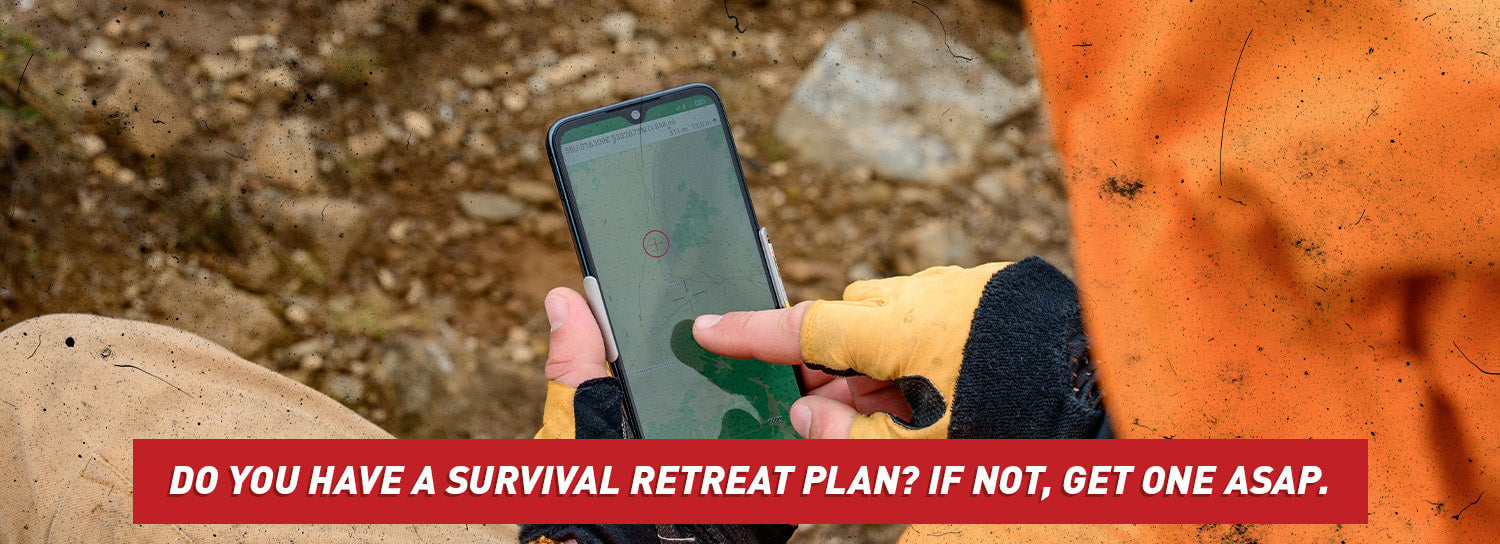Wired recently published a report all about Mark Zuckerberg’s top-secret Hawaii compound, which includes a 5,000-square-foot survival bunker with two mansions, a series of tunnels, and a blast-resistant door.
Whether we agree with Zuckerberg’s politics or not, we can agree with him on the need to prepare.
And though most of us do not have $260 million to spend on a doomsday bunker, we still can plan for a survival retreat if SHTF.
You’ve heard the term "bug out." You may even have a bug-out bag ready.
But have you carefully considered where you would actually bug out to?
This is what we're talking about when we say "survival retreat." It's the place you retreat to when SHTF.
Why a Retreat Plan Is Critical for Survival
Many people think they can just stock up on emergency preparedness gear and "bug in" at home with their stockpile.
If you have neighbors that are less than the best, it may not be ideal to stay where you are—especially if you live in a populated area.
Those "nice neighbors" might not be so nice when they get desperate enough.
If your neighbors know you have supplies, they WILL come for your emergency stash when SHTF. It'll be every man for himself.
This is why Zuckerberg’s compound has six-foot walls, security guards, and cameras everywhere.
Again, most of us don’t have Zuckerberg money or resources, but that shouldn’t stop you from protecting yourself, your family, and your supplies the best you can.
You need a plan to get out and stay out for as long as necessary.
Location Is Everything
The first thing you need to consider when planning a survival retreat is where you are headed.
The location is key.
In an ideal situation, you’d be able to build or find a small home or cabin in an isolated area with access to a natural water source.
As you consider places to go, be on the lookout for someplace small that doesn’t stand out. You also want to look for locations where nature works for you and against others.
For example, look for places in wooded areas or in the mountains, where the terrain makes it easier to hide and more difficult for newcomers to navigate.
Again, remember to keep water sources in mind. The closer you are to natural bodies of water, such as creeks and lakes, the better.
When considering the location for a survival retreat, distance is also paramount.
For example, when the worst-case scenario unravels, you may not be able to drive across the country—or even 100 miles.
Make sure that whatever location you plan to go for a survival retreat, you can quickly and easily get to it when the time comes.
It’s also important to consider the structure you will stay in.
Do you have the finances to secure a second small home or cabin? Can you purchase land and build a tiny home or fallout shelter on this land? Are you able to buy a motorhome? Is there a family member who is willing to let you stay at their private property?
What You’ll Need Aside from a Bug-Out Bag
In addition to having a bug-out bag ready, there are other things you’ll need to consider.
If you're able to secure a home to use as a survival retreat, you should stock plenty of emergency preparedness supplies inside.
The must-haves include long-term emergency food, power supplies, and water filtration tools.
But that's not all.
Should SHTF, you will need a vehicle of some sort to actually bug out.
Do you own a truck for carrying and hauling lumber and other building materials? Do you have an ATV with a trailer hitch?
When it comes to building and preparing a survival retreat, you need to consider power sources, too.
For instance, if you find an off-grid location, you’ll want a solar generator.
Similarly, even if you plan a survival retreat near a body of water, you’ll need water filtration tools to ensure the water is clean enough for drinking and sanitation.
Making an Escape Plan
You’ve got your supplies and you know where you’re headed.
How are you going to get there?
In a true disaster situation, you'll need to get up and go at a moment's notice.
Having an evacuation plan will make a huge difference in getting to your survival retreat safely… or at all.
Let’s say disaster strikes. If everyone is trying to get out of town, the roads will be congested and traffic will be at a standstill.
Not what you want.
You want to consider evacuation routes, unlike the rest of your neighbors. The fewer people, the better.
Take time to mark your route on a physical map that you keep with your bug-out bag in the event your GPS doesn’t work.
Even better, have multiple routes mapped out ahead of time.
Signs That It’s Go Time
Unless your survival retreat plan includes a holiday vacation-style compound like Zuckerburg, you won’t be going there often.
It’s where you will head when you absolutely need to.
How do you know when it’s time to go?
-
An extended portion of the grid goes down. This will be the beginning of a societal collapse. The longer you wait to leave, the more dangerous and difficult it will be to get to your location.
-
A major natural disaster occurs. It takes out power and prevents emergency services from entering the area for days on end.
-
The supply chain comes to a halt, or essential resources are no longer available.
-
The economy collapses.
- A civil war begins.
The basic rule of thumb is to get out before your home and neighborhood are no longer safe, or there is evidence of escalating violence near your home.
If you sense things are going from bad to worse, it’s go time, friends.
Stay safe out there.
In liberty,
Elizabeth Anderson
Preparedness Advisor, My Patriot Supply





